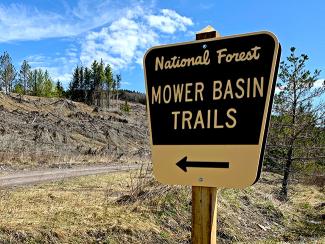Mower Tract Restoration Project


Purchased by the Forest Service in the late 1980s, the 40,000-acre Mower Tract is located on Cheat Mountain and has been the focus of red spruce restoration for over 10 years.
The goal of the Mower Tract restoration is to re-establish native red spruce forests, increase the water storage capacity of Cheat Mountain, improve water quality in the Shavers Fork watershed, and provide wildlife corridors for vulnerable and threatened species. The project replaces nonnative conifer plantations and grasses with red spruce and other native species to create early successional forests.
Spruce forests are historically native to Cheat Mountain at the higher elevations but were drastically reduced through logging projects followed by subsequent fires and/or strip mining before the Forest Service purchase in 1987-1988. Previous mineland reclamation efforts attempted to prevent erosion by soil compaction and the planting of nonnative conifers and grasses. This compaction and domination of nonnatives has prevented the regeneration of spruce forests and early successional habitat and reduced rainwater and snowmelt infiltration into the soil. Reversing this state of arrested succession is the focus of Mower Tract restoration projects. Holistic restoration will improve wildlife habitat in the short-term and increase spruce forests and watershed function and provide additional ecosystem services for future generations.
Spruce forests and the soils that develop under them store carbon and water better than compacted soils and even better than hardwood forests. Restoring spruce forests to Cheat Mountain will benefit species like the Cheat Mountain salamander, West Virginia northern flying squirrel, and many other species that are closely associated with spruce habitat. More information about specific wildlife benefits can be found in the “Mined Land Restoration” report by Green Forests Work.
To date, over 1,000 acres of mineland and wetlands have been rehabilitated and over 400,000 native plants have been planted. Organizations such as Green Forests Work, Appalachian Stewardship Foundation, Canaan Valley Institute, The Nature Conservancy, West Virginia Division of Natural Resources, and countless other partners have been essential to the success of the project.
Trail Maps
Reports
- Mined Land Restoration on the Mower Tract of the Monongahela National Forest 2010-2021
- 2017 Joint Chiefs Briefing Papers
- Mower Tract Restoration and Recreation Enhancement Project 2016 Environmental Assessment
- Mower Tract Ecological Restoration 2014 Progress Report
News Media
- Creating a New Spruce Forest for One Small Inhabitant
- Reclamation Green Forests Work, a nonprofit, is working with a team of experts to restore forests throughout Appalachia
- Former West Virginia Coal Mines Turned into Carbon-sucking Forests
- Once Degraded, West Virginia's Monongahela National Forest Is Restored to Glory
- Reclaiming Appalachia: A Push to Bring Back Native Forests to Coal Country
- Red spruce sprout atop coal mines that helped kill them
Related Links
- Implementing Landscape Scale Conservation across Organizational Boundaries: Lessons from the Central Appalachian Region, United States
- Monongahela National Forest: Lambert Restoration Project
Partners and Agencies
- American Forests
- Appalachian Regional Reforestation Initiative
- Arbor Day Foundation
- Green Forests Work
- Canaan Valley Institute
- Central Appalachian Spruce Restoration Initiative
- Appalachian Stewardship Foundation
- The Nature Conservancy
- USDA-NRCS Plant Materials Center
- West Virginia Division of Natural Resources
- West Virginia Division of Forestry


